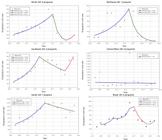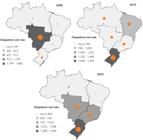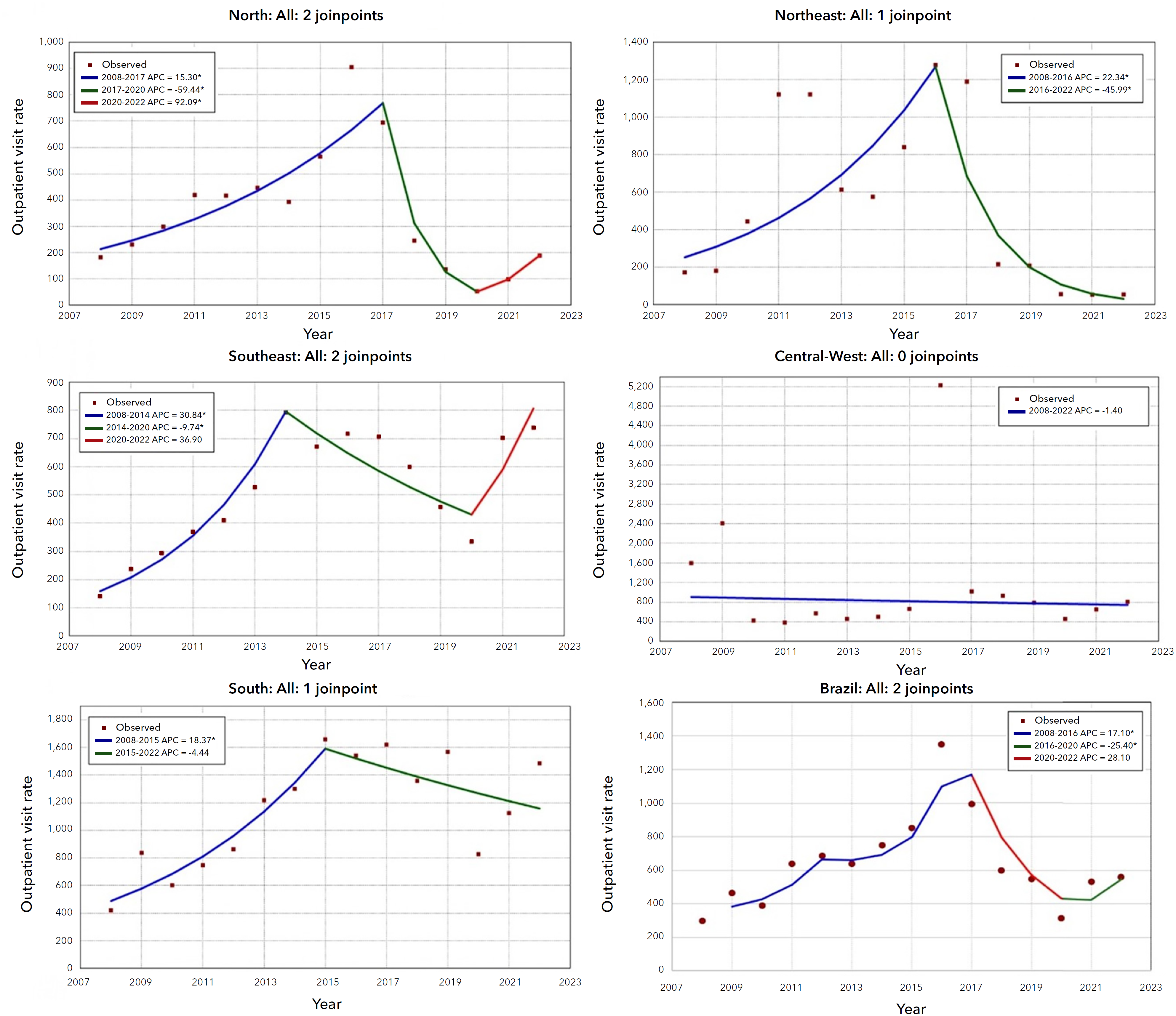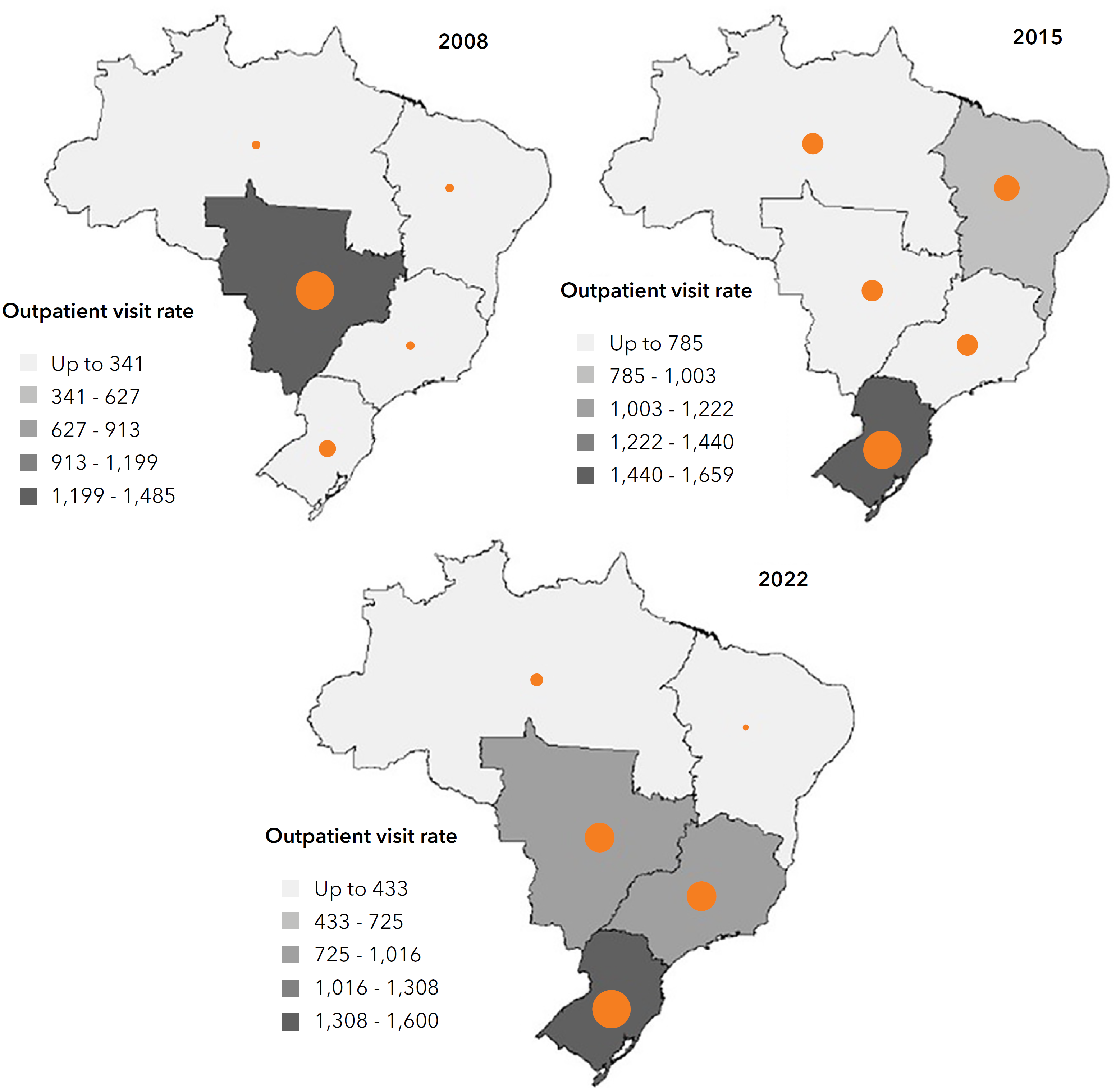Abstract
Introduction: Assessing health conditions based on out-patient care data is one of the tools used to support the development of an appropriate health action plan aimed at meeting the real needs of the population.
Objective: Analyze the spatiotemporal distribution of outpatient physiotherapy services in primary health care in Brazil and its geographic regions from 2008 to 2022.
Methods: This was an analytical ecological time series study using secondary data from the Outpatient Information System and Brazilian Institute of Geography and Statistics. The Kruskal-Wallis test was used to identify differences in outpatient care between regions by year and joinpoint regression to estimate temporal trends from 2008 to 2022.
Results: The South obtained the highest outpatient physiotherapy visit rates when compared to other Brazilian regions across six consecutive years from 2013 to 2022, except in 2016. Temporal trends in Brazil and the North, Northeast, and Central-West remained stationary between 2008 and 2022. However, there were significant increases of 12.3 and 6.4% in care provided in the South and Southeast, respectively. Spatial distribution by seven-year periods indicated high outpatient visit rates in the South in 2015 and 2022.
Conclusion: The temporal trend of outpatient physiotherapy services in Brazil from 2008 to 2022 was stationary in the North, Northeast, and Central-West, but experienced growth in the South and Southeast.
Keywords:
Primary health care; Physiotherapy formats; Outpatient care
Resumo
Introdução: Avaliar a situação de saúde por meio da produção ambulatorial é uma das ferramentas utilizadas para complementar a construção de um plano de ação de saúde adequado que vise atender às reais necessidades da população.
Objetivo: Analisar a distribuição espaço-temporal da produção ambulatorial de fisioterapia na Atenção Primária à Saúde no Brasil e suas regiões geográficas no período de 2008 a 2022.
Métodos: Trata-se de um estudo ecológico analítico de série temporal de dados secundários do Sistema de Informações Ambulatoriais e do Instituto Brasileiro de Geografia e Estatística. O teste de Kruskal-Wallis foi utilizado para identificar diferenças na produção ambulatorial entre as regiões por ano e a regressão de joinpoint para estimar a tendência temporal entre 2008 e 2022.
Resultados: A região Sul apresentou as maiores taxas de produção ambulatorial em comparação às demais regiões do Brasil em seis anos consecutivos, de 2013 a 2022, exceto em 2016. A tendência temporal no Brasil e nas regiões Norte, Nordeste e Centro-Oeste permaneceu estacionária entre 2008 e 2022. Entretanto, nas regiões Sudeste e Sul houve crescimento significativo de 12,3 e 6,4% nos atendimentos, respectivamente. A distribuição espacial por septênios demonstrou altas taxas de serviços ambulatoriais na região Sul em 2015 e 2022.
Conclusão: A tendência temporal dos atendimentos ambulatoriais de fisioterapia na Atenção Primária no Brasil e regiões Norte, Nordeste e Centro-Oeste foi estacionária, enquanto no Sudeste e Sul foram crescentes no período de 2008 a 2022.
Palavras-chave:
Atenção Primária à Saúde; Modalidades de fisioterapia; Assistência Ambulatorial
Introduction
Health assessment plays a critical role in transforming a given health situation into a more desirable scenario by improving public policies.1 The Brazilian Ministry of Health (MS from the Portuguese acronym) has prioritized management based on monitoring and evaluating processes and outcomes.2 In this respect, outpatient care is a strategic tool for assessing the performance and use of healthcare services.3 Among the different levels of health care, Primary Health Care (PHC) provides comprehensive services that meet 80 to 90% of an individual's needs throughout their life and is the preferred gateway to the Brazilian National Health System (SUS from the Portuguese acronym).4 As such, evaluating these services is essential to ensuring high-quality individual and community-based care.
The Family Health Support Center (NASF from the Portuguese acronym) was established in 2008 with the aim of expanding PHC services and integrating different professional categories into primary care, including physiotherapy.5 It was discontinued in 2020 and in 2023, through GM/MS Ordinance 635, became known as the Multiprofessional Team in Primary Health Care (eMulti).6,7
Outpatient physiotherapy is one of the most commonly provided services by PHC professionals.8 World Physiotherapy has highlighted the economic and health benefits of outpatient physiotherapy in PHC, including reductions in pain and disability, general practitioners’ workload, medication prescription rates, and work absenteeism. Moreover, these services improve individual health indicators, especially quality of life.9-13 With the growing demand for physiotherapy services,14 particularly due to the rise in disabilities associated with chronic conditions, PHC faces the challenge of coordinating the country's rehabilitative care and optimizing the use of medium- and high-complexity services.5 One of the strategies used to meet this demand is the provision of outpatient physiotherapy within PHC.15 Thus, evaluating use of this service is important in assessing health system performance and informing more effective decision making to meet the needs of the population.16,17 Currently, assessments of the evolution of physiotherapy care within PHC exist at the local level,18 but not on a national or regional scale. As such, this study aimed to analyze the spatiotemporal distribution of PHC outpatient physiotherapy services in Brazil and its geographic regions from 2008 to 2022.
Methods
This was an ecological time series study of PHC outpatient physiotherapy in Brazil and its five geographic regions (North, Northeast, South, Southeast, and Central-West) from January 2008 to December 2022. Data were obtained from the SUS Outpatient Information System (SIA/SUS) and Brazilian Institute of Geography and Statistics (IBGE).
The SIA/SUS is the main national system for out-patient service data provided by the Information Technology Department of the SUS (DATASUS), and the IBGE is Brazil's primary supplier of geographic and statistical data. Since the study used secondary data, there was no need for approval by the local Research Ethics committee.
The DATASUS system was accessed to obtain data from the health information, health care, and outpatient services sections, in that order. Under outpatient services, data were extracted for Brazil and its five geographic regions using the following parameters: number of approved procedures, primary care complexity level, and procedures for consultations with higher education-level professionals in primary care. Population data by year in Brazil and its geographic regions were obtained from the Brazilian demographic census or, when unavailable, from the estimated population figures provided in the ‘indicators’ section of the IBGE website.
The annual outpatient physiotherapy visit rate was calculated for Brazil and the geographic regions by dividing the total number of outpatient physiotherapy visits by the total population and multiplying the result by 100,000 inhabitants. The Kruskal-Wallis test, followed by Dunn's post hoc, was used to identify differences in outpatient care between the regions by year, with p < 0.05 considered statistically significant.
The temporal trend of outpatient care between 2008 and 2022 was analyzed by joinpoint regression using the Joinpoint Regression Program (version 5.0. 2). For the identification of temporal trend models by Brazilian region, the dependent and independent variables were outpatient care and year, respectively. A maximum of two joinpoints, a log-linear model, and heteroscedastic error variance were selected for model analysis. The weighted Bayesian Information Criterion (BIC) was applied for model selection. The annual percentage change (APC) and average annual percentage change (AAPC), both estimated using the parametric method and with 95% confidence intervals, indicated the direction and magnitude of the temporal trends. When no joinpoints were found, the APC was equivalent to the AAPC. Joinpoint regression models with p values ≤ 0.05 were statistically significant. Spatial distribution maps were produced using TabWin software.
Results
A total of 19,464,442 outpatient physiotherapy visits in PHC were identified in the SUS Outpatient Information System between 2008 and 2022. The ratio between the number of outpatient physiotherapy visits and the national population was 299 visits per 100,000 inhabitants in 2008 and 557 per 100,000 inhabitants in 2022. The highest outpatient physiotherapy visit rates per 100,000 inhabitants were recorded in the Central-West, North, and Northeast in 2016 and in 2014 and 2015 for the South and Southeast, respectively. The lowest rates were obtained in 2008 in the South and Southeast, and in 2020 and 2021 in the North and Northeast, respectively (Figure 1).
There were statistically significant differences between regions in various years across all the years analyzed (2008 to 2022). The South had the highest number of physiotherapy visits when compared to the North in six of the years studied (2013, 2014, 2015, 2017, 2019 and 2020), in relation to the North-east in three years (2018, 2021 and 2022) and to the Southeast in one (2010). The Southeast obtained a higher outpatient visit rate than the Central-West in 2008, 2009 and 2016, and compared to the Northeast in 2011 and 2021 (Figure 1).
Figure 2 shows the APC for the outpatient physiotherapy visit rate in Brazil and its geographic regions. Analysis of the 2008 to 2022 period indicates a stationary temporal trend in Brazil, the North, Northeast, and Central-West, and an increasing trend in the Southeast and South, with a significant 12.3 and 6.4 % rise in outpatient visits, respectively.
Temporal trend of the outpatient physiotherapy visit rate in primary health care in Brazil and the North, Northeast, South, Southeast, and Central-West regions from 2008 to 2022.
Other annual segments were identified across this same period that demonstrated increasing, decreasing, and stationary temporal trends in Brazil and its regions, except the Central-West. There were three annual trend periods in Brazil: the first from 2008 to 2016, showed an increasing trend of 17.1%, followed by a decreasing trend of -25.1% from 2016 to 2020, and finally a stationary trend between 2020 and 2022.
The Southeast and North also exhibited three annual trend periods. Similar to the national pattern, the Southeast exhibited an increasing trend of 30.8% from 2008 to 2014, decreasing -9.7% trend from 2014 to 2020, and a stationary trend between 2020 and 2022. In the North, there was an initial 15.3% increase from 2008 to 2017, followed by a -59.4% decline from 2017 to 2020. Unlike the stationary pattern observed for Brazil and the Southeast in the third period, the North showed a 92.1% increase in outpatient physiotherapy visits from 2020 to 2022. For the remaining regions, two annual trend segments were observed in the Northeast and South, with both regions displaying upward trends of 22.3 and 18.4%, respectively, in the first period, and a -46% decrease in the North and stationary trend in the South in the second period.
Figure 3 shows the spatial distribution of outpatient physiotherapy visit rates in the North, Northeast, Central-West, Southeast and South in 2008, 2015 and 2022, with heterogeneous distribution across the regions in these three years. Based on the results for 2008, the Central-West had the largest number of physiotherapists nationwide when compared to the other regions. In 2015, the South obtained the highest rates, followed by the Northeast, while the remaining regions showed lower and similar distributions. In 2022, the South remained the region with the highest number of physiotherapy visits in the country, followed by the Southeast and Central-West, while the Northeast obtained the lowest rate, unlike 2015.
Spatial distribution of outpatient physiotherapy visit rates in the North, Northeast, Central-West, Southeast and South in 2008, 2015 and 2022.
Discussion
PHC outpatient physiotherapy services play an important role in addressing rehabilitation needs, particularly for musculoskeletal disorders, a leading cause of rehabilitation demand worldwide.8,19 Demand for rehabilitation services increased by 63% from 1990 to 2019, highlighting the need to expand coverage within primary care.20-22 In this context, an increase in outpatient physiotherapy visits within PHC would be expected. However, our findings indicated a stationary trend from 2008 to 2022 in Brazil and the North, Northeast, and Central-West, whereas the South and Southeast exhibited an upward trend.
These findings may be related to the distribution of physiotherapists across the country. Despite the overall nationwide increase in the availability of these professionals, the rate of workforce expansion differs between regions, with the lowest availability recorded in the North and the highest in the South and South-east.23 Regional characteristics may also influence distribution. The North, characterized by larger distances and a widely dispersed population, tends to concentrate health professionals in metropolitan areas, resulting in barriers to service access and use. By contrast, the South is notable for its relatively low barriers and easier access to health services.24-26
Another important factor related to regional disparrities is the distribution of diseases across the population. Musculoskeletal disorders, especially low back pain, are the leading conditions treated in outpatient physiotherapy services in PHC. The incidence of work-related musculoskeletal disorders in Brazil from 2007 to 2019 showed an increasing trend across all regions of the country, except the Northeast, with the highest percentages recorded in the North (28.8%) and South (27.7%).27 This scenario contributed to the growing demand for rehabilitation services, which may have influenced the upward trend in PHC outpatient physiotherapy rates in the South. However, this behavior was not observed in the North.
Socioeconomic conditions also vary across regions, which directly affects the population's health status and, consequently, the healthcare performance measured by outpatient service delivery, among other indicators. Despite the improvement in health indicators in the North and Northeast, substantial disparities remain when compared to other regions of Brazil,28 which may have contributed to the disparate findings in outpatient physiotherapy care.
Increasing, decreasing and stationary trends in PHC outpatient physiotherapy were identified in Brazil and the North, Northeast, South, and Southeast regions. These trends may be associated with changes in public health policies during these time periods. From 2008 to 2016, the outpatient physiotherapy visit rate increased by 17.1%, possibly due to the rise in the number of PHC physiotherapists between 2007 and 2016 and greater federal funding for the implementation of NASF teams, created in 2008, within healthcare units.29
Following this growth period, there was a decline in PHC outpatient physiotherapy visits in Brazil from 2016 to 2020. This may have been influenced by Ordinance 2.436 of 2017, which modified the nomenclature and coverage of NASF care. The Family Health Support Center became the Expanded Family Health and Primary Care Center (NASF–AB) and its services were extended to include other healthcare teams. These changes led to an increased demand for matrix support services and integrated activities within primary care units,30 which may have contributed to the reduction in outpatient services.
Moreover, the spatial distribution of outpatient visit rates in 2008, 2015 and 2022 reflects the heterogeneity of PHC physiotherapy care across the country over the years, with the greatest growth observed in the South, followed by the Central-West and Southeast. This disparity may be associated with unequal NASFAB implementation across the country.31
The limitations of this study are primarily related to its use of secondary data from databases that may contain incomplete information and are subject to on going updates. A key strength is that this is the first national-level study to analyze PHC outpatient physiotherapy services. Trends in outpatient physiotherapy visits in Brazil and its geographic regions varied over the 15-year period investigated, with some years showing increasing or decreasing trends and others remaining stable. The results obtained indicate regions with the highest use of outpatient physiotherapy services. These findings, combined with the disparities identified, provide a broader understanding of the population's health status, particularly in terms of the health system's capacity to meet the growing demand for these services. Understanding outpatient service delivery allows for an important comparison between the availability of healthcare professionals and the volume of services they effectively provide to the population.
Conclusion
There was no significant change in PHC outpatient physiotherapy visit rates in Brazil or the North, North-east, and Center-West regions. On the other hand, the South and Southeast showed a significant increase in outpatient service rates. Despite the increased availability of physiotherapists across Brazilian regions, the disparities observed in outpatient care may reinforce existing inequalities in healthcare access among the regions.
References
-
1 Sousa AN. Monitoramento e avaliação na atenção básica no Brasil: a experiência recente e desafios para a sua consolidação. Saude Debate. 2018;42(spe 1):289-301. https://doi.org/10.1590/0103-11042018S119
» https://doi.org/10.1590/0103-11042018S119 - 2 Brasil. Saúde mais perto de você-acesso e qualidade: Programa Nacional de Melhoria do Acesso e da Qualidade da Atenção Básica (PMAQ): manual instrutivo. Brasília: Ministério da Saúde; 2014.
-
3 Brasil. Manual instrutivo do PMAQ para as equipes de Atenção Básica (Saúde da Família, Saúde Bucal e Equipes Parametrizadas) e NASF. 2 ed. Brasília: Ministério da Saúde; 2015. https://bvsms.saude.gov.br/bvs/publicacoes/manual_instrutivo_pmaq_atencao_basica.pdf
» https://bvsms.saude.gov.br/bvs/publicacoes/manual_instrutivo_pmaq_atencao_basica.pdf -
4 Organização Pan-Americana da Saúde. Atenção Primária à Saúde [cited 2024 Feb 20]. Available from: https://www.paho.org/pt/topicos/atencao-primaria-saude
» https://www.paho.org/pt/topicos/atencao-primaria-saude - 5 Brasil. Departamento de Atenção Básica. Diretrizes do NASF: Núcleo de Apoio a Saúde da Família. Brasília: Ministério da Saúde; 2009.
- 6 Brasil. Portaria GM/MS No 635, de 22 de maio de 2023. Institui, define e cria incentivo financeiro federal de implantação, custeio e desempenho para as modalidades de equipes Multiprofissionais na Atenção Primária à Saúde. Brasília: Diário Oficial da União; 2023 May 22.
- 7 Brasil. Departamento de Saúde da Família. Nota Técnica No 3/2020-DESF/SAPS/MS. Brasília: Mistério da Família; 2020.
-
8 Bim CR, Carvalho BG, Trelha CS, Ribeiro KSQS, Baduy RS, González AD. Physiotherapy practices in primary health care. Fisio Mov. 2021;34:e34109. https://doi.org/10.1590/fm.2021.34109
» https://doi.org/10.1590/fm.2021.34109 -
9 Demont A, Bourmaud A, Kechichian A, Desmeules F. The impact of direct access physiotherapy compared to primary care physician led usual care for patients with musculoskeletal disorders: a systematic review of the literature. Disabil Rehabil. 2021;43(12):1637-48. https://doi.org/10.1080/09638288.2019.1674388
» https://doi.org/10.1080/09638288.2019.1674388 -
10 Igwesi-Chidobe CN, Bishop A, Humphreys K, Hughes E, Protheroe J, Maddison J, et al. Implementing patient direct access to musculoskeletal physiotherapy in primary care: views of patients, general practitioners, physiotherapists and clinical commissioners in England. Physiotherapy. 2021;111:31-9. https://doi.org/10.1016/j.physio.2020.07.002
» https://doi.org/10.1016/j.physio.2020.07.002 -
11 Bornhöft L, Thorn J, Svensson M, Nordeman L, Eggertsen R, Larsson MEH. More cost-effective management of patients with musculoskeletal disorders in primary care after direct triaging to physiotherapists for initial assessment compared to initial general practitioner assessment. BMC Musculoskelet Disord. 2019;20(1):186. https://doi.org/10.1186/s12891-019-2553-9
» https://doi.org/10.1186/s12891-019-2553-9 -
12 Ojha HA, Snyder RS, Davenport TE. Direct access compared with referred physical therapy episodes of care: a systematic review. Phys Ther. 2014; 94(1):14-30. https://doi.org/10.2522/ptj.20130096
» https://doi.org/10.2522/ptj.20130096 -
13 Long J. European region of the WCPT statement on physiotherapy in primary care. Prim Health Care Res Dev. 2019;20:e147. https://doi.org/10.1017/s1463423619000811
» https://doi.org/10.1017/s1463423619000811 -
14 Goulart BNG, Anderle P. Rehabilitation: a rising demand that calls for action. Codas. 2019;32(2):e20190120. https://doi.org/10.1590/2317-1782/20192019120
» https://doi.org/10.1590/2317-1782/20192019120 -
15 Rodes CH, Kurebayashi R, Kondo VE, Luft VD, Góes AB, Schmit ACB. The access and rehabilitation working process in Primary Health Care. Fisioter Pesqui. 2017;24(1):74–82. https://doi.org/10.1590/1809-2950/16786424012017
» https://doi.org/10.1590/1809-2950/16786424012017 - 16 Brasil. Departamento de Regulação, Avaliação e Controle. Manual técnico operacional SIA/SUS- Sistema de Informações Ambulatoriais. Brasília: Ministério da Saúde; 2010.
-
17 Medeiros KR, Machado HOP, Albuquerque PC, Gurgel Jr GD. O Sistema de Informação em Saúde como instrumento da política de recursos humanos: um mecanismo importante na detecção das necessidades da força de trabalho para o SUS. Cienc Saude Coletiva. 2005;10(2):433-40. https://doi.org/10.1590/S1413-81232005000200021
» https://doi.org/10.1590/S1413-81232005000200021 -
18 Aleluia IRS, Sodré N, Barreto A, Lisboa R, Santos FC, Pereia Jr E. Análise da produção ambulatorial de fisioterapia no SUS, Bahia, 2008-2014. Rev Gestao Saude. 2017;8(2): 254-69. https://periodicos.unb.br/index.php/rgs/article/view/3724
» https://periodicos.unb.br/index.php/rgs/article/view/3724 -
19 Melo AA, Toledo AM, Emiliano L, Padula RS, Carregaro RL. Characterization of the procedures and professional practices of primary care physiotherapists in Brazil. Work. 2022; 73(2):547-57. https://doi.org/10.3233/wor-205138
» https://doi.org/10.3233/wor-205138 -
20 Cieza A, Causey K, Kamenov K, Hanson SW, Chatterji S, Vos T. Global estimates of the need for rehabilitation based on the Global Burden of Disease study 2019: a systematic analysis for the Global Burden of Disease Study 2019. Lancet. 2021;396(10267):2006-17. https://doi.org/10.1016/s0140-6736(20)32340-0
» https://doi.org/10.1016/s0140-6736(20)32340-0 -
21 Maseko L, Myezwa H, Benjamin-Damons N, Franzsen D, Adams F. Service guidelines, models, and protocols for integrating rehabilitation services in primary healthcare in Brazil, Russia, India, China, and South Africa: a scoping review. Disabil Rehabil. 2024;46(22):5144-57. https://doi.org/10.1080/09638288.2023.2290210
» https://doi.org/10.1080/09638288.2023.2290210 -
22 Silva DB, Sixel TRS, Medeiros AA, Mota PHS, Bousquat A, Schmitt ACB. The workforce for rehabilitation in primary health care in Brazil. Hum Resour Health. 2021;19(1):127. https://doi.org/10.1186/s12960-021-00669-x
» https://doi.org/10.1186/s12960-021-00669-x -
23 Gomes SM, Miranda GMD, Sousa FOS, Nascimento CMB, Lima MLLT, Silva VL, et al. Physical/functional rehabilitation in Brazil: spatiotemporal analysis of the offer in the Public Healthcare System. Cienc Saude Coletiva. 2023;28(2):373-83. https://doi.org/10.1590/1413-81232023282.09112022EN
» https://doi.org/10.1590/1413-81232023282.09112022EN -
24 Garnelo L, Lima JG, Rocha ESC, Herkrath FJ. Access and coverage of Primary Health Care for rural and urban populations in the northern region of Brazil. Saude Debate. 2018;42 (spe 1):81-99. https://doi.org/10.1590/0103-11042018S106
» https://doi.org/10.1590/0103-11042018S106 -
25 Matsumura ESS, Sousa Jr AS, Guedes JA, Teixeira RC, Kietzer KS, Castro LSF. Geographical distribution of physiotherapists in Brazil. Fisioter Pesqui. 2018;25(3):309-14. https://doi.org/10.1590/1809-2950/17027025032018
» https://doi.org/10.1590/1809-2950/17027025032018 -
26 Oliveira RAD, Duarte CMR, Pavão ALB, Viacava F. Barriers in Access to services in five Health Regions of Brazil: perceptions of policymackers and professionals in the Brazilian Unified National Health System. Cad Saude Publica. 2019;35 (11):e00120718. https://doi.org/10.1590/0102-311x00120718
» https://doi.org/10.1590/0102-311x00120718 -
27 Lima AGCF, Ribeiro CJN, Lima SVMA, Barbosa YM, Oliveira IM, Araújo KCGM. Space-time analysis of work-related musculoskeletal disorders in Brazil: an ecological study. Cad Saude Publica. 2024;40(7):e00141823. https://doi.org/10.1590/0102-311xen141823
» https://doi.org/10.1590/0102-311xen141823 - 28 Silva MLA, Raposo IO, Silva LESC, Assunção JES, Rolim TM, Souza ABM, et al. Vulnerabilidade social, fome e pobreza nas regiões Norte e Nordeste do Brasil. In: Almeida FA, editor. Políticas públicas, educação e diversidade: uma compreensão científica do real. Guarujá: Editora Científica Digital; 2020. p. 1083-106.
-
29 Rodés CH, Daré JVL, Araujo BC, Graciani L, João SMA, Germani ACCG, et al. The physiotherapy workforce in the Brazilian Unified Health Care System. Hum Resour Health. 2021;19(1):101. https://doi.org/10.1186/s12960-021-00642-8
» https://doi.org/10.1186/s12960-021-00642-8 -
30 Brocardo D, Andrade CLT, Fausto MCR, Lima SML. Núcleo de Apoio à Saúde da Família (NASF): panorama nacional a partir de dados do PMAQ. Saude Debate. 2018;42(spe 1): 130-44. https://doi.org/10.1590/0103-11042018S109
» https://doi.org/10.1590/0103-11042018S109 -
31 Guimarães RM. Does the inverse theory hypothesis apply to primary health care? Evidence from 5564 Brazilian municipalities. Rev Panam Salud Publica. 2018;42:e128. https://doi.org/10.26633/rpsp.2018.128
» https://doi.org/10.26633/rpsp.2018.128
Edited by
-
Associate editor:
Ana Paula Cunha Loureiro
Publication Dates
-
Publication in this collection
16 June 2025 -
Date of issue
2025
History
-
Received
04 June 2024 -
Reviewed
07 Oct 2024 -
Accepted
18 Mar 2025

 Spatiotemporal analysis of outpatient physiotherapy services in primary health care
Spatiotemporal analysis of outpatient physiotherapy services in primary health care





